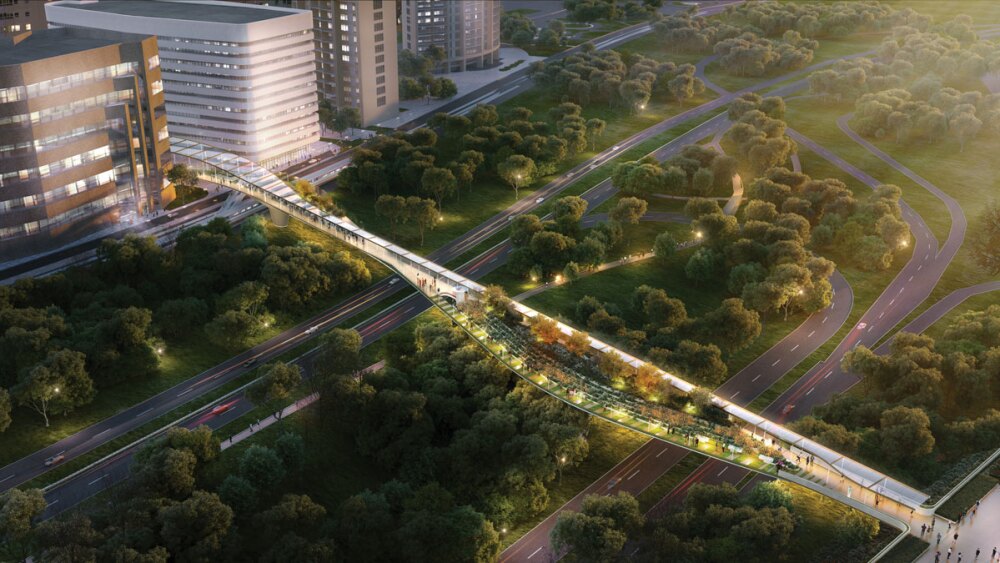Current and upcoming federal infrastructure funding opportunities—including through the Bipartisan Infrastructure Law (BIL) and the Inflation Reduction Act (IRA)—have the potential to spur resilient, sustainable, and equitable outcomes for cities. But how can real estate developers access and leverage this funding and play a role in shaping infrastructure decisions to drive sustainability outcomes in cities?
Approximately $394 billion over the next 10 years will be spent on decarbonization and converting the grid to clean energy through the IRA, according to McKinsey & Co. Through 2026, at least $550 billion will be spent on U.S. transportation networks and other projects through the BIL, according to the White House. More federal funds through the BIL will be spent on energy efficiency and conservation, brownfield clean-up, reducing pollution, and removing or retrofitting highways that divide communities, among other projects (a collection of ULI resources related to federal infrastructure through the IRA and BIL is available at uli.org/federalfunding).
Investments in decarbonization by developers can have financial returns in the form of lower operating costs, increased property values, and attraction and retention of tenants. Furthermore, reducing greenhouse gas emissions and creating communities that are less reliant on cars can support developer and tenant ESG goals.
The availability of IRA funding for building decarbonization investments through rebates, grants, tax credits, and tax deductions—especially when combined with state and local incentives—is expected to significantly increase opportunities for developers to achieve profitable outcomes.
Although investments made through BIL focus primarily on infrastructure, they have the potential to catalyze complementary projects. For example, public investments in highway conversions that improve public transportation, walkability, and access to green space may unlock opportunities for adjacent real estate development. The synergy between private and public investments can ultimately lead to cleaner air, more opportunities for people to engage with nature, and more resilient communities overall.
The availability of IRA funding for building decarbonization investments through rebates, grants, tax credits, and tax deductions—especially when combined with state and local incentives—is expected to significantly increase opportunities for developers to achieve profitable outcomes.
Building the business case
While federal agencies continue to issue guidance on accessing the billions of dollars of IRA funds to construct and retrofit sustainable and resilient buildings, leading real estate developers are planning now for the incorporation of decarbonization technologies due to demand and long-term ROI.
Specific provisions in the IRA legislation expected to support increased ROI for real estate projects include:
- The IRA creates more predictability for tax deductions so developers can plan and take advantage of them. For example, the IRA lowered barriers to eligibility, increased maximum deduction amounts, and made these changes permanent to Section 179D of the tax code.
- IRA tax credits can be used to mitigate the cost of otherwise potentially expensive upfront investments for retrofits.
- Developers have an increased ability to install emerging technologies thanks to expanded tax credits for energy efficiency and renewable energy investments. Those developers can also receive incentives for installing such technology in low-income areas and paying workers the prevailing wage.
- Real estate investment trusts (REITs) can receive and transfer tax credits through the IRA. Previously they could not access these credits, as they do not pay taxes directly. REITs and other companies with little or no tax liability can transfer the full or partial benefits of IRA tax credits to third parties, in some cases including direct payments that are allowed only for state and local governments and nonprofits.
- Tax credits and tax deductions can be stacked for new construction projects and retrofits. Previously, a developer who added a geothermal heat system, solar panels with storage, and EV charging to a building could access multiple tax credits, according to The Real Estate Roundtable.
- Most tax credits and deductions are increased for affordable housing developments.
Other compelling reasons for green upgrades to buildings—such as those possible through the IRA—include:
- Buildings save significant amounts of money when decarbonization technologies are introduced. The EPA estimates energy consumption savings of 20 percent to 40 percent with aggressive retrofits on existing buildings and cost savings of 6 percent to 9 percent.
- Developers who leverage investments can future-proof their buildings and portfolios and may, thus, have more valuable buildings—for example, according to ULI’s Net Zero for All report, studies have documented rental premiums of 3.5 percent and sale premiums around 13 percent for highly efficient buildings, as well as occupancy rates up to 7 percent higher because of better tenant attraction and retention.
- Consumers and investors demand buildings with decarbonization technologies. Most Americans (74 percent) support participation in international efforts to combat climate change, according to a 2023 Pew Research survey; a 2021 survey by JLL found that 70 percent of investors planned to have a budget allocation in place by 2025 to address energy efficiency and carbon reduction.
Federal funding in action
Companies including the Washington, DC region’s JBG Smith—a REIT with a portfolio of 15 million square feet (1.4 million sq m) of office, multifamily, and retail assets—are evaluating how to leverage opportunities like ones offered by IRA and BIL, including at National Landing, a mixed-use development in Northern Virginia anchored by Amazon HQ2.
“We are exploring the change in rules for REITs introduced for onsite renewable technologies—including our development in Arlington, Virginia,” says Kimberly Pexton, senior vice president, sustainability, for JBG Smith. “While the IRA allows REITs to monetize tax credits, the market for off takers is in its infancy.”
Infrastructure improvements through the BIL are likely to encourage the expansion of complementary developments.
“We invest in National Landing because of its rich and expanding multimodal transportation network,” says Jay Corbalis, vice president, public affairs, at JBG Smith. “We don’t necessarily build projects because of specific infrastructure decisions, but, in general, federally funded infrastructure investments in multimodal transportation—transit, walking, and biking—can support the types of resilient and healthy developments we aim to create.”
At ULI’s 2023 Fall Meeting, Sara Neff, head of sustainability for Lendlease Americas, spoke about the potential of IRA tax credits for a project’s bottom line, as well as several of the challenges in accessing funds. “You can’t apply for funds until a project is put into service,” says Neff. “With our geothermal facility, we spent the money several years ago, but that project is not going to stabilize until 2026.”
BIL investments in sustainable development
According to PwC and the Urban Land Institute’s Emerging Trends in Real Estate 2023, new federal funding will play an important role in needed investment in public transportation, which can support real estate success.
The infrastructure funding bill will provide almost $600 billion in transportation funding. These dollars and other federal infrastructure funds can be used to support equitable, resilient, and climate-friendly transportation investments—including bicycle lanes and micromobility facilities. The bill allocates more than $90 billion to modernize transit, improve accessibility, and continue existing transit programs. It also provides critical funding for enhancing environmental resilience for buildings and expanding water availability.
For much of this funding, however, state and local leaders have significant flexibility regarding which projects to support, meaning that funds can be spent on priorities likely to increase greenhouse gas emissions, including new highway construction and expansion. How new federal funds are used will play a major role in setting the path for the country’s economic, social, and environmental future.
Developers and other land use professionals have an opportunity to provide leadership in local infrastructure conversations—including by encouragement of spending on resilient, sustainable, and equitable priorities, and by making the case to local leaders that such investments can support both community priorities and economic and real estate development.
Leveraging public funds with private real estate investments can produce further benefits for communities and developers alike. For example, efforts to reconnect communities divided by highway infrastructure through projects that include public art, sidewalks, or parks—including through the BIL’s Reconnecting Communities Pilot program—may unlock opportunities for adjacent real estate development with beneficial features, such as green roofs, new trees, and access to nature for area residents. With community
coordination focused on equitable development, these complementary investments can ultimately lead to cleaner air, additional opportunities for people to engage with nature, and more resilient communities overall. ULI’s Transportation Transformations report highlights ways that highway conversions can pave the path for more inclusive and resilient places—including by accessing BIL and IRA funds.
Funding equitable community priorities
Both BIL and IRA include goals to support community equity, including by connecting historically disadvantaged and underserved communities to jobs, improving public health, reducing pollution, and increasing access to affordable clean energy.
For example, in 2023, Tallahassee, Florida received a $15 million RAISE grant through the BIL to invest in construction of Southside Transit Center (SSTC), a new bus transit facility that will integrate multiple transportation modes in a place defined by the Department of Transportation as an “Area of Persistent Poverty.” According to Tallahassee’s assistant city manager, Abena Ojetayo, the SSTC will feature solar panels to help power the facility and electric charging bus bays to accommodate the city’s growing EV fleet.
The investment in planning for the SSTC is already leading to additional investment in the area. “The new transit center has spurred several adjacent infrastructure, flood mitigation, and beautification projects, including a new public park, sidewalk improvements, street lighting, and stormwater facilities,” says Ojetayo. “A block away, our local housing authority is now also redeveloping a multifamily residential complex—this is the largest development in the agency’s history and will inject more than 300 new affordable housing units into the community.”
Accessing available funding
Federal grant funds, including through IRA and BIL, are generally allocated either directly to states—which then use the funds or distribute them to local government or private organizations—or directly to private entities, to individuals, or to both. Basic steps in directly accessing funds include:
Learn about current funding opportunities. ULI will share relevant information and resources at uli.org/federalfunding. A searchable list of funding opportunities is available at Grants.gov. Such organizations as the Urban Sustainability Directors Network regularly update the list of open opportunities.
Discuss tax implications with a professional. The array of tax credits and deductions can be complex, so it’s best to work with a professional who understands how to leverage these incentives for specific projects.
Determine eligibility. Eligibility requirements are set by both legislation and federal agency policies, and depend on entity type—for-profit company, city government, etc.
Register. All federal funding applicants need active SAM.gov and Grants.gov registrations to apply. It is important to register earliy, as the processing may take several weeks.
Complete application and submit.
Seven BIL and IRA programs and funding opportunities for real estate to know
Developers and communities may be able to profit from BIL and IRA programs. Some of the programs expanded or funded by the BIL and the IRA most relevant to the real estate industry include:
Public/private partnerships: The BIL increased the availability of Private Activity Bonds for surface transportation projects to $30 billion. The program lets state governments issue municipal bonds that give private developers and operations with access to tax-exempt interest rates that lower the cost of capital for public works projects, including broadband and carbon-capture projects, according to JLL. The BIL also allots $20 million annually in grants to states, localities, and tribal governments to help them navigate potential P3 projects, either through building their teams or retaining expert services.
Discretionary grant funding programs: The BIL includes such initiatives as the Reconnecting Communities Pilot program, which funds construction projects to reconfigure transportation facilities, highways, and streets that create barriers to mobility, access, or economic development, and offer opportunities for adjacent real estate development.
Neighborhood Access and Equity Grants: The IRA includes more than $3.2 billion for the Neighborhood Access and Equity Grants program, with $1.1 billion set aside for low-income communities. The program supports projects that improve walkability, safety, and affordable transportation access in communities, as well as address environmental harm caused by transportation projects in disadvantaged communities.
RAISE: The BIL also includes discretionary grant funding to support “safety, environmental sustainability, quality of life, mobility and community connectivity, economic competitiveness and opportunity including tourism, state of good repair, partnership and collaboration, and innovation” through the RAISE program. For example, RAISE funds were used in Chula Vista, California, to eliminate a dangerous rail crossing that separated Palomar Street from the rail corridor, making it safer for people regardless of whether they walk, bike, or roll.
HUD grants and loans: HUD’s Green and Resilient Retrofit Program, funded through the IRA, provides grants and direct loans for retrofits to conserve energy and water in HUD-assisted affordable multifamily housing.
EPA grants and loans: Authorized by the IRA and funded with $27 billion, the EPA’s Greenhouse Gas Reduction Fund (GHGR) provides low-cost loans for carbon reduction projects in affordable multifamily housing. EPA also offers community grants to states, local governments, community-based organizations, and nonprofits for similar green upgrades.
Home Energy Rebates: The Energy Department’s IRA-funded Home Energy Rebate Programs offer multifamily developers rebates for installing high-efficiency HVACs and appliances, with higher rebates for multifamily affordable housing.
Once in a generation
The IRA and the BIL potentially provide a once-in-a-generation investment in sustainability, equity, and resilience, but some uncertainties linger around accessing IRA funds for buildings as rules get clarified. Despite this issue, it is worth continuing to explore new federal funding streams for energy-efficiency retrofits or investments in new developments in the IRA, and to push for BIL investments used in ways that benefit communities and produce more sustainable development patterns and real estate opportunities.
In the case of IRA tax credits, a company’s first project will probably be the toughest—especially as guidance from the federal government continues to evolve. After that, however, the tax credit from one development could help fund the next project, leading to a chain of tax-credit-support projects that play an important role in building decarbonization.
Future Urban Land articles will delve further into specific federal funding opportunities and will explore how real estate can benefit from these funds and access them. Stay tuned for more.







